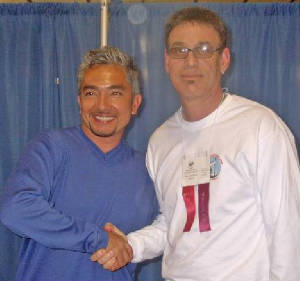Most pet owners have met someone that is afraid of dogs. This known as “Cynophobia,” which translates to “phobia of dogs.” Those with cynophobia experience severe emotional distress and anxiety not only when they come into contact with dogs, but when they think about coming into contact with dogs. Phobias can be so severe that the individual requires therapy to address it.
Humans, however, are not the only animals that can develop a phobia. Dogs can too, developing phobias of humans due to their experiences as puppies or a lack of socialization. This is especially common they were mistreated or experienced any pain at the hands of a human during their developing years – something that may have happened if you adopt a rescue dog.
As a dog trainer in Chicago – and someone that also works remotely with dog owners all over the United States – I can tell you that working with dogs that have been mistreated is difficult but rewarding. It takes time and ongoing training, but it can be one of the most fulfilling experiences you have as an owner.
What Can Be Done?
I want to encourage you to call me if your dog is showing signs of a phobia of humans (known as anthropophobia, though this term is usually only used to describe people). We can meet, talk together about your dog’s experiences with human beings, and then come up with a professional plan to address it. In the interim, however, you can make sure that you’re working on the following:
Creating a Safe and Trusting Environment
The first step in training your dog out of human phobia is to establish a sense of safety and trust. Your dog needs to feel secure in their environment and understand that you are a source of comfort and protection. This can be achieved by:
- Providing a Safe Space - Create a designated area in your home where your dog feels secure. This could be a crate, a cozy corner, or a dog bed. Ensure this space is free from foot traffic and sudden noises, and let your dog retreat there whenever they feel overwhelmed.
- Maintaining a Calm Demeanor - Dogs are highly sensitive to human emotions. If you remain calm and composed, your dog will be more likely to feel safe. Avoid raising your voice or making sudden movements around your dog, as this can increase their anxiety.
- Avoid Harsh Punishments – You should always avoid any physical or loud punishments of dogs, but this is especially important if your dog has a human phobia. Any confirmation that humans are to be feared in any form may make the fear worse.
You will want to make sure that you’re always putting your dog is safe and comforting situations to give your pet the best chance at overcoming their fear.
Gradual Desensitization and Exposure
Audrey Jung, a Phoenix therapist and owner of Jung Psych Services writes “Desensitization is a process that involves slowly introducing a person to the source of their fear.” It is a service used in cognitive behavioral therapy to help individuals “learn to feel safe in the presence of their phobias by exposing them to the fear and helping their minds and bodies learn that nothing will happen.”
The same process can be used for dogs. You can introduce your dog to the source of their fear - in this case, humans - in a controlled and non-threatening manner. This technique helps your dog learn that people are not a danger.
This process should be completed in a planned way, meaning that you should make sure the humans that are a part of the process are safe, and have time for it. That is because humans that come and go (for example, those that are walking by you on a trail) do not give your dog enough time to habituate to them.
Instead, try the following:
- Start from a Distance - Keep your dog on a leash. Begin by having a person, or a group of people, stand at a distance where your dog can be aware of them. Reward your dog with treats, praise, or play when they remain calm in the presence of the person. Gradually decrease the distance over time as your dog becomes more comfortable.
- Introduce Low-Intensity Interactions - Once your dog is comfortable with people at a distance, start having them interact with calm, relaxed individuals. Ask the person to avoid direct eye contact, crouch down to the dog’s level, and extend an upside down hand with a treat. This allows the dog to approach on their own terms without feeling pressured.
- Increase the Level of Interaction - Gradually progress to having the person talk to your dog in a soft voice, pet them gently, or offer them a toy. Always keep the sessions short and positive, ending on a successful note to build your dog’s confidence.
Be careful about accidentally rewarding unwanted behaviors. You will want to make sure that your dog is showing signs of being calm. Pay attention to cues. If you give your dog a treat while they’re fearful, it may create more fear.
Using Positive Reinforcement
Positive reinforcement is one of the most effective tools for changing your dog's behavior. By rewarding your dog for calm and confident behavior around humans, you help them form positive associations with people. Use high value treats and offer rewards any time your dog is showing positive signs towards humans.
Avoid Forcing Interactions
One of the most important aspects of training a dog with human phobia is allowing them to progress at their own pace. Never force your dog into a situation where they feel overwhelmed, as this can reinforce their fear and hinder progress. For example, avoid pulling your dog toward a person or allowing strangers to approach them quickly. Instead, let your dog take the lead in interactions and withdraw if they show signs of stress, such as panting, yawning, or cowering.
Introducing New People Gradually
When your dog has made progress with familiar people, start introducing them to new individuals. Begin with one new person at a time, ensuring they follow the same calm, non-threatening approach used during training. Encourage guests to ignore your dog initially, allowing them to approach when they feel ready. This method reinforces the idea that new people are not a threat and can help reduce fear over time.
Patience and Persistence
Training a dog out of human phobia is a gradual process that requires time and patience. Every dog progresses at their own pace, and setbacks are normal. Celebrate small victories, and continue to provide positive reinforcement as your dog becomes more comfortable around people.
If you’d like help with this process, reach out to Chicago Dog Trainer today. We can help those locally to Chicago, and support anyone in the US that is open to remote dog training using Zoom or other video conferencing services.





